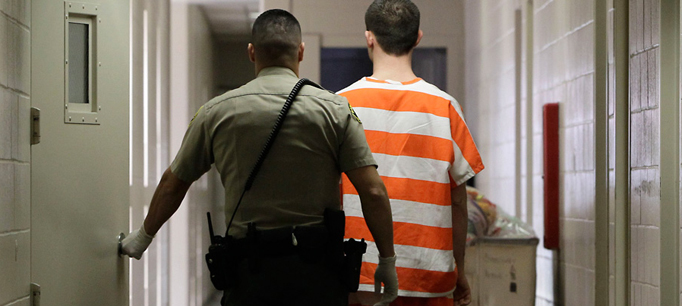As legislators prepare to consider the state budget, the Senate Budget and Fiscal Review Committee took a broad look at public safety realignment at a hearing this week. The committee invited PPIC research fellow Magnus Lofstrom to testify about the impact of this major change in corrections policy on crime in California.
My name is Magnus Lofstrom. I am a research fellow at the Public Policy Institute of California. As many of you know, PPIC is a nonpartisan, independent research institute focused on major policy issues in the state. I have been asked to provide an overview of recent crime trends in California to help set the context for your decisions.
The source of crime data most commonly used by researchers is the FBI’s annual Uniform Crime Report, which covers crimes reported or identified by law enforcement agencies. The data fall into two broad categories: violent crimes (murder, rape, robbery, and aggravated assault) and property crimes (burglary, larceny theft, and motor vehicle theft). The published FBI crime statistics for California are compiled by the California Department of Justice’s Criminal Justice Statistics Center, which also makes more-detailed monthly data available to the public.
The vast majority of crimes reported in California are property crimes—about 87 percent in 2012. Among these, 61 percent are larceny thefts, 23 percent are burglaries, and 16 percent are motor vehicle thefts. Aggravated assaults and robberies account for 94 percent of violent crime (59% and 35% respectively). Close to 5 percent of reported violent crimes are rapes and slightly more than 1 percent are homicides.
Crime rates in California have been coming down for some time and have reached historic lows (Figure 1). The decline in violent crime dates back to the early 1990s, while the property crime rate has seen a year-to-year decrease in most years since 1980. Although there is no consensus among researchers on the causes of the long-term decline, factors that typically drive trends include changes in sentencing laws and incarceration, demographics (for example, age and race/ethnicity), economic conditions, the dynamics of illegal drug markets, law enforcement officer levels, and policing strategies. The influence of these factors on crime trends varies with the type of crime.
Importantly, the most recent data indicate that the long-term trends might be reversing. This is especially noticeable for property crimes.
After reaching a 45-year low in 2011 of 412 violent crimes per 100,000 residents, in 2012 California’s violent crime rate went up slightly to 422. Nonetheless, the 2012 violent crime rate is at a historically low level—about one-third of its 1992 peak. In 2012, California’s violent crime rate was higher than the national rate of 387 per 100,000 residents and ranked 16th among all states.
The number of property crimes in California increased by 7.6 percent between 2011 and 2012, driving the property crime rate up from 2,586 to 2,757 per 100,000 residents. As with violent crime, property crime is substantially below its peak of 6,939 in 1980. California’s property crime rate continues to be below the national rate (2,859 per 100,000 residents in 2012) and ranked 24th among all states in 2012.
Crime rates vary substantially across the state (Table 1). The highest violent crime rates in 2012 were in San Joaquin and Alameda Counties (889 and 765 violent crimes per 100,000 residents, respectively). The lowest were in the relatively small counties of Placer and Trinity (188 and 155, respectively). We also see dramatic differences across counties in property crime. For example, San Francisco’s property crime rate of 4,848 in 2012 was more than three times higher than the property crime rates in Modoc, Lassen, and Trinity Counties (1,630, 1,578, and 1,383, respectively).
Recent changes in the number of crimes also vary dramatically across the state (Table 2). For example, violent crime went up by 11.6 percent between 2011 and 2012 in Contra Costa, but it decreased by 3.4 percent in Los Angeles. Property crime increased by 23.2 percent in Santa Clara, 18 percent in Alameda and 15.6 percent in Kern –all more than double the 7.6 percent statewide increase—while it increased by only 0.2 percent in Fresno.
Because the recent reversal of statewide crime trends coincided with the implementation of public safety realignment in 2011, questions have been raised about the role of the reform. Motivating these questions is the increase of so-called “offender street time.” Our research shows that about 18,000 offenders who in past years would have been in either prison or jail are not incarcerated now as a result of realignment. We also find that these changes did not affect counties equally. Counties that relied more heavily on the state prison system before realignment saw bigger increases in offender street time. This was especially true in counties that faced serious jail capacity constraints, including the 18 counties with court-ordered jail population caps.
In our research, we assess the extent to which realignment contributed to the recent increases in crime. Our primary approach is to compare changes caused by realignment in county incarceration rates to changes in crime rates (which vary both across counties and over time). That is, we examine the potential effect of changes in street time on crime. To increase our confidence in the results and put them in the context of national changes, we also compare California’s crime trends to trends in other states. Let me begin my discussion with the latter analysis.
In our comprehensive analysis, we find no convincing evidence that realignment has contributed to increases in violent crime, so far. Instead, the recent modest increase in violent crime appears to be part of a broader trend, also seen in other states (Figure 2).
In contrast, our research provides strong evidence that realignment has caused an increase in property crime. In contrast to California’s 7.6 percent increase, property crime nationwide decreased slightly—by 0.9 percent—between 2011 and 2012. Moreover, California’s property crime trend matches up very well with trends in comparable states before realignment, but it starts to diverge in 2011 (Figure 3).
Our analysis of county crime and incarceration data supports what we found in the analysis of state crime trends. The changes in incarceration rates caused by realignment have not led to an increase in violent crime so far, but there has been an increase in property crime, particularly auto thefts. We estimate an additional 1.2 motor vehicle thefts per year for each offender not incarcerated as a result of realignment (Figure 4).
Our estimates translate to an increase in the auto theft rate of about 65 more thefts per year per 100,000 residents. To put it slightly differently, realignment caused an increase of about 24,000 auto thefts per year. It is worth noting that even with this increase, auto theft rates remain historically low. They are now at the levels we observed as recently as 2009.
These estimates can be used to compare the costs of incarceration to its effect in preventing crime. This cost-benefit exercise shows that the state has not gotten a good return on its investment: an additional dollar spent on incarceration yields only about 23 cents in terms of the crimes averted.
The limited impact of incarceration on crime prevention can also be seen by comparing the effects of prison incarceration and policing. If we were to spend an additional dollar on policing rather than incarceration, we could prevent 3.5 to 7 times as many crimes. Of course, additional policing is only one possible alternative to incarceration. Researchers and policymakers can and should explore many policy options.
As California’s major public safety reform continues to unfold, our work highlights the need for the state and the counties to consider a variety of ways to handle their public safety responsibilities effectively and cost-efficiently.


